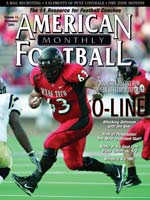AMERICAN FOOTBALL MONTHLY THE #1 RESOURCE FOR FOOTBALL COACHES
Article CategoriesAFM Magazine
|
It Starts in the Trenches5 Coaches discuss the fundamentals and techniques involved in teaching the o-lineby: Richard Scott © More from this issue Juan Castillo has coached offensive linemen at the high school and Division II level. He’s also spent the past 11 years with the Philadelphia Eagles. Throughout this career, the daily principles he brings to his job have remained the same. “To me it’s still the same – it’s all about fundamentals,” Castillo said. “When I was at Texas A&I, I was fortunate to learn a lot of my drills from NFL coaches and major college coaches, but I still break it down the way I did at the small college level. We still do fundamentals and you’ve got to keep teaching them. “If you do a good job of coaching fundamentals your guys will be successful and they’ll know it. They’ll see it when they watch tape and see the results.” It’s arguable that no area in sports requires more attention to fundamentals and....The full article can only be seen by subscribers. Subscribe today!
|
|
|||||||
| HOME |
MAGAZINE |
SUBSCRIBE | ONLINE COLUMNISTS | COACHING VIDEOS |
Copyright 2026, AmericanFootballMonthly.com
All Rights Reserved





